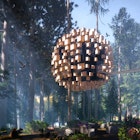
A reason to travel to Swedish Lapland this winter: Icehotel 33

Dec 16, 2022 • 5 min read

Icehotel 33 is now open with new designs and rooms © Asaf Kliger / ICEHOTEL
Looking for a great reason to start planning your next adventure? In this series, we share the most compelling events, attractions and experiences that will have you booking a trip to the world’s most exciting destinations.
- placement: fullWidth
- path: articles/in-content-top
- possible size: [970, 250], [970, 90], [728, 90], [300, 250], [320, 50], [1, 1],
- targeting:
{ "url": "reason-to-visit-sweden-icehotel", "destination": "Lappland", "continent": "Europe", "country": "Sweden", "region": "Lappland" }
Every November, as temperatures drop and the aurora borealis dances overhead, a new Icehotel takes shape in Jukkasjärvi, Sweden, 200km (125 miles) north of the Arctic Circle in Swedish Lapland. Then, as temperatures rise in the spring, the Icehotel melts back into Torne River, from which its ice was harvested. While it lasts, the Icehotel is much more than just a place to stay. It’s a stunning wintry art gallery of themed spaces carved in ice by artists from around the world. Each art suite is unique and lasts only as long as that year’s winter season.

Icehotel 33 opened December 16, making the 33rd annual incarnation of this intriguing concept, with 12 themed art suites created by 24 artists from 10 countries, along with 24 simpler ice rooms, a ceremonial hall and a main hall with 40 ice columns. Overnight guests get free admission to the entire hotel during the day; if you don’t want to stay overnight, you can buy an admission ticket to see the ice art as a day visitor.
Even if you’re traveling to Sweden during the warmer months, you can still see some ice art and experience a night in the cold. In addition to the annually rebuilt structure – Icehotel Winter, open December through April – there’s a year-round facility called Icehotel 365, which uses solar energy to keep its ice rooms frozen all year long. Here, you’ll find 18 ice suites and the Experience Room, which tells the story of Icehotel and preserves some of the ice art created in previous years.
Jukkasjärvi is a village of about 900 people just east of Kiruna, the largest town in Swedish Lapland. It’s quick and easy to get to Icehotel from Kiruna Airport by taxi or rental car – though if you’re arriving in winter, we recommend the atmospheric journey by dogsled, a trip that takes 90 minutes and which can be booked directly with the hotel.
- placement: fullWidth
- path: articles/in-content-middle
- possible size: [970, 250], [970, 90], [728, 90], [300, 250], [320, 50], [1, 1],
- targeting:
{ "url": "reason-to-visit-sweden-icehotel", "destination": "Lappland", "continent": "Europe", "country": "Sweden", "region": "Lappland" }

Sweden’s far north is one of the best places in the world to see the aurora borealis (northern lights). If you’re visiting during the fall and winter, as you wait for the night skies to light up with magical color, there are plenty of outdoor activities to keep you busy, including dogsledding, ice fishing, snowmobiling, snowshoeing, cross-country skiing or trying your hand at ice sculpting. In summer, the glorious midnight sun illuminates Arctic Sweden, with long days for hiking, fishing, white-water rafting, camping or simply simply enjoying a meal over a cozy campfire. Many guided activities can be booked directly through Icehotel. Don’t miss the chance to experience the 10-step Jukkasjärvi sauna ritual, which includes relaxation in a traditional sauna, a roll in the snow, a dip in the icy Torne River and a soak in a heated outdoor bathtub.
Jukkasjärvi is also a great place to learn about the culture of Scandinavia’s Indigenous people, the reindeer-herding Sámi. Nutti Sámi Siida is a Sámi-owned local tourism business in Jukkasjärvi that offers a variety of cultural and outdoor activities.

Eat
In Icehotel’s main (heated) restaurant you can choose from a regular menu featuring local ingredients – or pre-book the multi-course “ice menu,” with dishes served on plates made of ice from the Torne River. At the Veranda, a tasting menu inspired by the eight seasons of the Sámi year is a great way to sample the flavors of Swedish Lapland. At the Old Homestead, a cluster of 18th-century wooden buildings that also house a museum, you can dine on casual fare such as pizza and grilled selections in what was once the village schoolhouse.
- placement: native
- path: articles/in-content-native
- possible size: [f, l],
- targeting:
{ "url": "reason-to-visit-sweden-icehotel", "destination": "Lappland", "continent": "Europe", "country": "Sweden", "region": "Lappland" }
Alternatively, book a tour that includes a wilderness lunch along with a seasonal outdoor activity. Depending on the season, you might eat lunch around a campfire or in a cabin surrounded by wild nature.
If you’re interested in delving deeper into the traditional food culture of Arctic Sweden, book Nutti Sámi Siida’s Arrangaddis dinner in Jukkasjärvi, a six-course meal featuring Sámi dishes rarely available in restaurants, accompanied by stories about the food and traditional Sámi singing known as jojk. Or try Camp Ripan in Kiruna, whose creative menu reflects the region’s three cultures: Swedish, Sámi and Torne Valley Finnish.

Drink
In a hotel made of ice, of course there’s a bar made of ice, too. Located in the year-round section of the hotel, the Icebar is redesigned every year by international artists and maintains a constant temperature of about -5°C (23°F). Everything is made of Torne River ice, from the bar counter and walls to the furniture and even the glass your drink is served in. There’s also a lounge behind the hotel reception, open from December to April, serving light meals, hot drinks, beer and wine.
Stay
All ice rooms and suites have bed frames made of ice, each with a wooden base supporting a thick mattress covered with reindeer hides, pillows and a warm sleeping bag. Room temperatures hover between -5 and -8 °C (18° to 23°F). At Icehotel Winter, rooms have thick drapes across the doorways for privacy; while there are no bathrooms or storage for personal belongings – you literally just sleep there – all guests have access to facilities in the heated reception building. In contrast, Icehotel 365 has deluxe ice suites with doors, heated full bathrooms and space for luggage. Traditional warm hotel rooms and chalets are also available. The hotel recommends spending one night in an ice room and the rest of your stay in a warm room.
If you’re looking for something different before or after your Icehotel stay, Nutti Sámi Siida’s Reindeer Lodge has accommodations inspired by the Sámi way of life, from forest cabins to traditional and modern tents. In Kiruna, Camp Ripan also has four bright cabins with different room configurations, as well as a gorgeous spa with year-round indoor and outdoor facilities.
- placement: fullWidth
- path: articles/bottom
- possible size: [970, 250], [970, 90], [728, 90], [300, 250], [320, 50], [1, 1],
- targeting:
{ "url": "reason-to-visit-sweden-icehotel", "destination": "Lappland", "continent": "Europe", "country": "Sweden", "region": "Lappland" }
Explore related stories



 Wildlife & NatureSweden vs Norway: which Scandinavian country beckons for you?
Wildlife & NatureSweden vs Norway: which Scandinavian country beckons for you?Jul 28, 2023 • 6 min read
 ArchitectureThis floating tree house in Sweden surrounded by bird boxes is not your average hotel room
ArchitectureThis floating tree house in Sweden surrounded by bird boxes is not your average hotel roomMar 24, 2022 • 2 min read
 Festivals & EventsThe best times to visit Sweden, from Midsummer sun to winter fun
Festivals & EventsThe best times to visit Sweden, from Midsummer sun to winter funFeb 18, 2022 • 7 min read

 HotelsEnjoy the night sky without the cold at these innovative Arctic cabins
HotelsEnjoy the night sky without the cold at these innovative Arctic cabinsOct 22, 2020 • 2 min read


